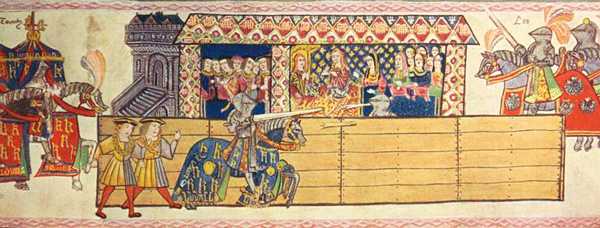Tournaments (1)
The tournament, introduced into England from France, was legalized by Richard I in 1194. It originated as a practical exercise in battle technique, but soon (especially after the general use of gunpowder) developed into a courtly ceremonial. Wrestling* was also an important part of tournaments.
The popularity of tournaments during the Elizabethan period coincided with the literary revival of chivalric ideals in works like Sidney's Arcadia, Spenser's The Faerie Queene, and Ariosto's Orlando Furioso.
The Renaissance tournament began and ended with a procession of Challengers, Defenders and their retainers, and featured three types of combat:
- First, and most important, was the Joust Royal, or "tilting," in which mounted knights armed with lances charged at their opponents across a barrier.
- This was followed by a "tourney" in which mounted knights ran at each other without a tilt barrier (as pictured here).>
- Combatants armed with spears and swords also fought on foot over a barrier (see next page).
Primary sources concerning arts of combat.
Footnotes
-
Wrestling
In the earlier years of Elizabeth's reign, wrestling bouts were an integral part of Court tournaments and jousting: it was considered a useful discipline for the soldier, since it would increase his skill in hand-to-hand battle.
Click to go to an illustration of wrestling following classical models, by an Italian artist of the mid-sixteenth centure.
